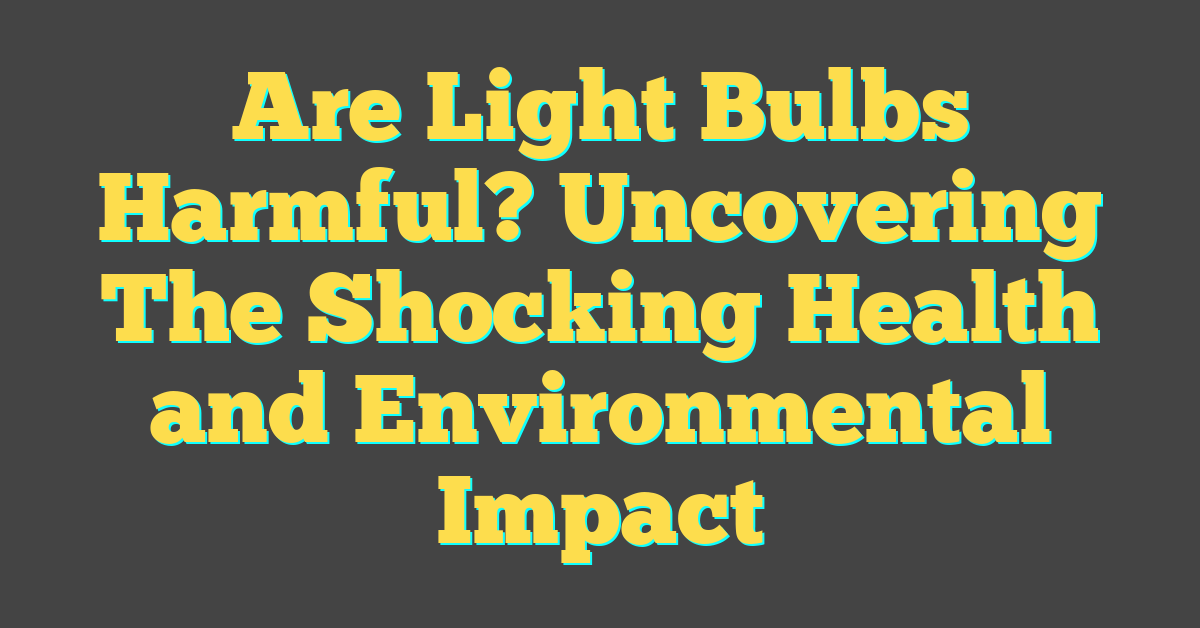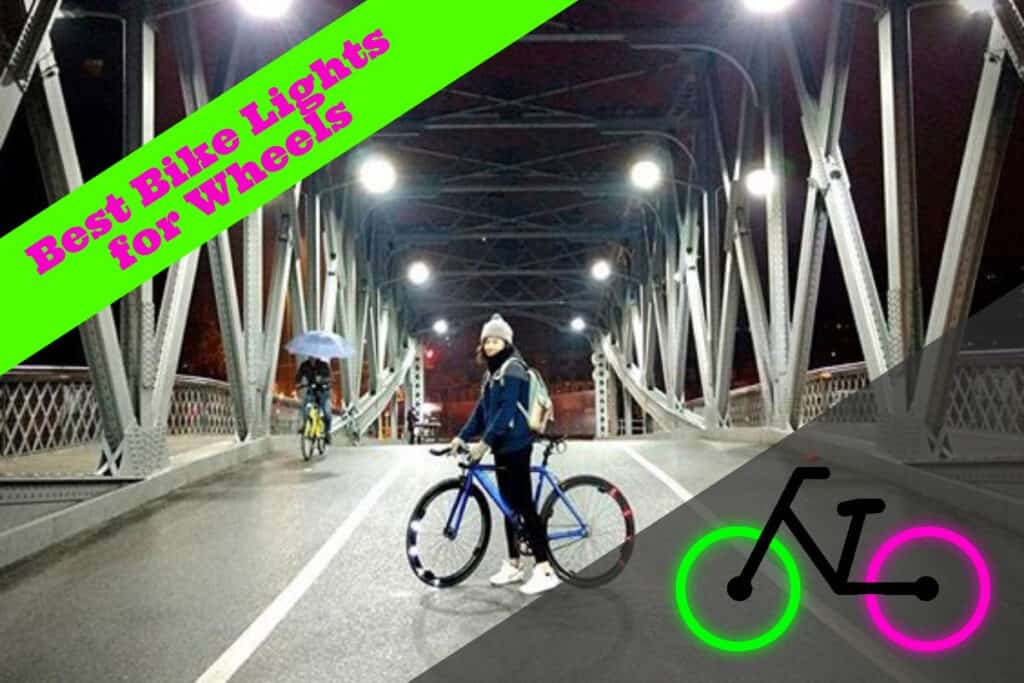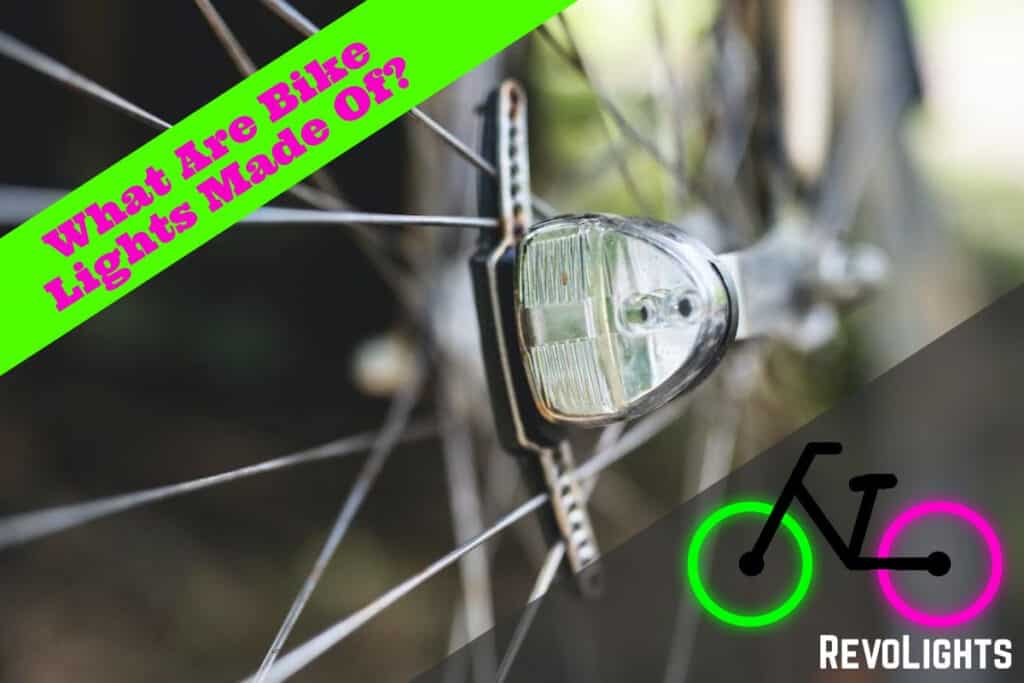You’ve probably never given it much thought while flipping the switch, but have you ever wondered if those everyday light bulbs are doing more than just illuminating your space? It’s a question that’s flickered in the back of many minds, especially as we strive for healthier lifestyles.

From the soft glow of a lamp to the bright beams of overhead fixtures, light bulbs are integral to your daily life. But beneath their luminous presence, could there be a hidden health impact? Let’s shed some light on the subject and find out if it’s all just a bright idea or a cause for concern.
The Basics of Light Bulbs
Light bulbs have come a long way since their incandescent ancestors first brought artificial light to our lives. Now, you’ve got a range of options that suit your every need, whether you’re striving for efficiency, aesthetics, or health consciousness in your DIY lighting projects.
Understanding Lumens and Watts
When you’re out shopping for bulbs, lumens are your indicator of brightness, while watts measure energy consumption. A higher lumen count means a brighter light, and fewer watts indicate greater efficiency.
- Energy-efficient bulbs like LEDs and CFLs may have higher upfront costs but they save you money in the long run due to lower energy usage and a longer lifespan.
Color Temperature Matters
A bulb’s color temperature, measured in Kelvins (K), affects the mood and functionality of a room.
- Warm lights (2500K–3000K) are cozy and inviting, perfect for living rooms and bedrooms.
- Cool lights (3500K–4100K) are clear and crisp, great for kitchens and bathrooms.
- Daylight bulbs (5000K–6500K) mimic natural light and can help in task-focused areas like home offices.
The LED Revolution
LEDs are the frontrunners in modern lighting solutions. They’re incredibly energy-efficient and contain no mercury, unlike their CFL counterparts. What’s best, they also offer a variety of color temperatures.
- Dimmable LEDs allow for adjusting the light intensity, adding versatility to a room.
- Smart LED bulbs can connect to your home’s Wi-Fi for remote control, even when you’re not home.
As you navigate the choices in lighting, keep in mind that while aesthetics are essential, the health implications of various bulb types can’t be ignored. Stay tuned as we delve further into that aspect, ensuring your home remains a sanctuary of both beauty and wellbeing.
The Different Types of Light Bulbs

When you’re diving into the sea of lighting choices, it’s essential to know your options. Traditional incandescent bulbs have lit our homes for over a century, yet they’re slowly being phased out in favor of more energy-efficient types due to their high energy use and shorter lifespan.
Energy-efficient bulbs like compact fluorescent lamps (CFLs) and light-emitting diodes (LEDs) are not just kinder to your wallet over time but are also more considerate of our environment. CFLs use about 70-80% less energy than incandescents and can last up to ten times longer. Despite their slow start-up time and the small amount of mercury which requires careful disposal, they’re an excellent step towards efficiency.
LEDs are taking the spotlight as the frontrunner in the energy-saving race. These bulbs use around 75% less energy and can last 25 times longer than incandescent bulbs! They come in a variety of shapes, brightness levels, and colors to fit any fixture or mood. Plus, they’re free of toxic materials and are often dimmable, giving you full control over your lighting intensity.
Don’t overlook halogen incandescents and high-intensity discharge (HID) bulbs as well. Halogens are a step up from standard incandescents, offering a cleaner light and modest energy savings, and HIDs, while more common in commercial spaces, boast intense brightness and long life, perfect for outdoor areas or large halls.
As you consider swapping out your current bulbs or installing new fixtures, remember:
- Look at lumens for brightness—not watts
- Check the color temperature for your intended ambiance
- Consider smart LED bulbs for the ultimate in control and customization
Every bulb type brings its flair to the grand design of your home’s lighting setup. With dimmable LEDs and smart tech, the power to fine-tune your house’s illumination is literally at your fingertips. Whether creating an invigorating home office or a cozy reading nook, your choices in lighting play the pivotal role in setting the right atmosphere.
How Light Bulbs Work

« What Light Bulbs Look Yellow? Unveil the Perfect Atmosphere for Each Room
How to Get Rid of Light Bulbs UK: The Ultimate Disposal Guide »
When you’re selecting light bulbs for your home, it’s not just about choosing bulbs that aren’t harmful – you also want to understand how they work. Let’s break it down so you can make more informed decisions for your DIY lighting projects.
Incandescent bulbs, the old standby of residential lighting, produce light by heating a metal filament until it glows. The process is simple: electricity heats up the filament to such a high temperature that it starts to emit light. But here’s the catch – only about 10% of the energy they use results in visible light; the rest is lost as heat. That’s why these bulbs are less energy-efficient compared to their modern counterparts.
Compact Fluorescent Lights (CFLs) work a bit differently. They contain a gas that produces ultraviolet light when an electric current stimulates it. This ultraviolet light then interacts with a fluorescent coating inside the bulb’s glass casing, emitting visible light. They use about 70% less energy than incandescents, making them a favorite for energy-saving enthusiasts.
Light-Emitting Diodes (LEDs) really take the efficiency game to another level. They utilize a semiconductor to convert electricity directly into light. No filaments, no gas, just a material that emits light when electrified. It’s this process that gives LEDs their long service life and makes them the darling of the eco-friendly lighting world.
Halogen incandescents have a capsule inside that holds gas around a filament to increase bulb efficiency. This creates a brighter, white light, which is perfect for task lighting. Halogens are more efficient than traditional incandescents but less so than CFLs and LEDs.
With such diverse technologies underpinning the humble light bulb, your ability to tailor lighting to your needs has never been greater. Whether you’re crafting the perfect ambiance, spotlighting your latest art acquisition, or just trying to read in the comfort of your living room, understanding how your light bulbs work can help you add both functionality and character to your spaces.
Potential Health Risks of Light Bulbs

While light bulbs illuminate your surroundings beautifully and enable you to create the ambience of your choice, they bring a few health concerns to the table that you should be aware of. Not all light emitted is created equal and understanding the potential health risks associated with light bulbs can give you an upper hand in mitigating any negative effects.
Firstly, there’s something called blue light, predominantly emitted by LEDs and other energy-saving bulbs. It’s known to disrupt your circadian rhythm if you’re exposed to it excessively at night. Notably, it may suppress melatonin production, the hormone that regulates sleep, leading to difficulties such as insomnia or poor sleep quality.
UV radiation is another concern, primarily with compact fluorescent lamps (CFLs). While the amount of UV rays reaching you from these bulbs is small, prolonged exposure, especially in close proximity, could potentially lead to skin and eye issues over time.
An often overlooked aspect is the flicker frequency of some light bulbs. Flickering, sometimes imperceptible, can cause eye strain, headaches, and even exacerbate conditions like epilepsy. The flicker in LED and fluorescent bulbs stems from fluctuations in electrical current, and continuous exposure, especially in your peripheral vision, can be detrimental to your health.
Additionally, the materials in the bulbs themselves sometimes pose risks. For example, CFLs contain a small amount of mercury, a hazardous substance. If a CFL bulb breaks, it releases mercury vapor, which you certainly don’t want to breathe in or handle without proper precautions.
- Melatonin suppression due to blue light exposure, impacting sleep patterns
- Potential UV radiation from CFLs, affecting skin and eyes
- Flicker frequency leading to eye strain and headaches
- Hazardous materials, like mercury in CFLs, posing a risk upon breakage
It’s crucial to consider these risks when selecting light bulbs for your home, especially in areas where you spend a lot of time. Proper placement, bulb types, and even lamp shades can help minimize potential health hazards. Always follow best practices for disposal, especially with bulbs containing toxic substances, to keep your home safe and maintain optimal health.
Blue Light and Its Effects on Sleep

You’re probably aware that getting a good night’s sleep is crucial for your overall health. What you might not know is that the light bulbs you choose can significantly impact your sleep patterns, especially when it comes to blue light exposure. LED light bulbs, while energy-efficient, emit a higher amount of blue light compared to other bulb types.
This blue light mimics natural daylight, which can interfere with the production of the sleep hormone melatonin. When the environment is supposed to signal your body that it’s time to wind down, those bright LEDs may be doing just the opposite. As you indulge in late-night projects or settle in with a book, the lighting you’re using could inadvertently reset your internal clock, leading to difficulty falling asleep or staying asleep.
To mitigate these effects, consider these steps:
- Use bulbs with a warmer color temperature in the evenings.
- Install dimmer switches to reduce light output before bedtime.
- Explore bulbs that are specifically labeled as low blue light emissions.
Recent studies have shown that prolonged exposure to high levels of blue light could also affect eye health, contributing to digital eye strain and increasing the risk of macular degeneration. And while it’s not practical to avoid blue light entirely – after all, it’s pretty much everywhere – managing your exposure can make a significant difference.
Lighting manufacturers are recognizing these concerns, and many now offer a range of products geared towards minimizing blue light exposure. With smart LED bulbs, you can even program light levels to shift towards a warmer spectrum as bedtime approaches. So before you flick that switch again, think about how your light bulb choice aligns with your sleep health. With a few simple adjustments, you can create a sleep-friendly environment that won’t leave you counting sheep.
UV Radiation and Skin Damage
When you’re picking out light bulbs, you might not immediately connect them with ultraviolet radiation, often abbreviated as UV. UV radiation is a type of energy produced by the sun that can damage the skin and cause it to age prematurely. What might surprise you is that some artificial light sources also emit low levels of UV radiation.
Compact Fluorescent Lamps (CFLs), for instance, can emit UV radiation due to the way they produce light. Inside each spiral tube is a gas that, when excited by electricity, emits UV light. The inside of the tube is coated with a phosphor that converts the UV light into visible light. However, some UV radiation can escape from CFLs, especially if the inner phosphor coating is cracked or if the bulb is of poor quality.
Even though the amount of UV exposure from CFLs is minimal compared to what one might experience outdoors, over time, prolonged exposure could potentially lead to skin damage, particularly if you’re frequently within close proximity to these bulbs. For example:
- Desk lamps used for reading
- Under-cabinet lighting in a kitchen
- Work lamps in a home office or workshop
Are you’re a DIY enthusiast who spends hours under the glow of a task light? It’s worth considering the type of bulb overhead.
Managing UV Exposure from Light Bulbs
LED bulbs, widely praised for their efficiency, also boast lower UV emissions than CFLs. If you’re particularly concerned about UV exposure, you might want to transition to LED bulbs. Not only will you save on energy costs, but you’ll also reduce the potential long-term effects of UV exposure on your skin.
In addition to switching to LEDs, here are some quick tips to minimize your risk:
- Use light fixtures with shades or diffusers that help block UV rays.
- Place lamps at a reasonable distance to avoid close and direct skin exposure.
- Opt for LED bulbs specifically engineered to have minimal UV emissions.
For you, the weekend warrior converting your basement into the next clever workshop, consider the impact of your light sources. Bright ideas should lead to bright spaces that are not only conducive to creativity but also mindful of health. Choose wisely and shine safely.
Mercury and Environmental Impact
When it comes to the darker side of illumination, you can’t overlook the environmental impacts of certain light bulbs. Specifically, CFLs (compact fluorescent lamps) come under scrutiny because they contain mercury. Although the amount per bulb is quite small, the collective disposal of these bulbs presents a real environmental challenge.
Mercury is a potent neurotoxin, and even small amounts in landfills can lead to contamination of the soil and waterways. It’s critical for you, especially as a home DIY enthusiast who cares about sustainability, to dispose of these bulbs properly. Many local waste facilities have special provisions for handling CFLs, ensuring that the mercury doesn’t escape into the environment.
Beyond disposal, the production of light bulbs also has a footprint. The manufacturing process for both LEDs and CFLs involves materials that may be sourced from environmentally sensitive areas. However, between the two, LEDs are often championed for their greener profile, as they last longer and do not contain mercury.
But don’t let this put a damper on your eco-friendly projects. You’ve got options to minimize your impact:
- Opt for LED bulbs that are certified by environmental standards, indicating lower energy consumption and a longer lifespan.
- Participate in or organize community recycling drives for safe disposal of CFLs.
- Stay informed about advances in bulb technology that further reduce environmental impact.
By taking these steps, you’ll not only brighten your home but also contribute to a healthier planet. Remember, every choice in your DIY lighting projects can have a ripple effect on the environment, so make decisions that you’ll be proud of for years to come.
Minimizing the Impact of Light Bulbs
When you’re brightening up your space, it’s also smart to think about the footprint your illuminating choices leave on the planet. Proper disposal is key to minimizing the harmful effects of light bulbs, especially those containing hazardous substances like mercury. Here’s how you can lighten that impact:
- Recycle CFLs and other bulbs at designated facilities or through recycling programs. This prevents mercury from ending up in landfills and potentially leaching into groundwater.
- Choose LED bulbs that bear a certification mark from recognized environmental standards, ensuring they meet specific criteria for energy efficiency and environmental safety.
- Look into local community recycling drives, which often include a section for electronics and bulbs. This way, you’re contributing to a larger, community-wide effort to reduce waste.
Beyond disposal, you can also make lifestyle choices that reduce the need for excess lighting:
- Maximize the use of natural light in your home. Position furniture and mirrors to reflect light deep into rooms, negating the need for artificial sources during the day.
- Install light dimmers to control the intensity of your lighting based on the time of day or the task at hand, which can extend bulb life and save energy.
- Favor task-based lighting solutions, such as desk lamps or under-cabinet lights in the kitchen, to illuminate only the areas you’re using rather than a whole room.
But it doesn’t stop there: It’s time to get your hands dirty with some creative DIY projects that emphasize both functionality and eco-friendliness. For instance, you could repurpose old glass jars into chic pendant lamps—combining artistry with utility and giving new life to objects that might otherwise be discarded.
Remember, every bulb you use has a lifecycle, and you’re in control of how it begins and ends. By taking these steps, you’re not only ensuring the health and safety of your home environment, but you’re also playing a vital role in protecting our planet. Tread lightly, and let your light shine brightly without casting a shadow on Mother Earth.
Conclusion
So you’ve seen how the light bulb choices you make can impact both your health and the environment. Remember to weigh the pros and cons of each bulb type and consider how their features affect your well-being and the planet. With the right knowledge and a bit of effort, you can ensure that your lighting choices are safe, efficient, and environmentally friendly. Don’t forget to recycle and explore creative ways to repurpose old bulbs. By doing so, you’re not just illuminating your space—you’re also paving the way for a brighter, healthier future.
Frequently Asked Questions
What types of light bulbs are available?
Different types of light bulbs include incandescent, LED (Light Emitting Diodes), and CFL (Compact Fluorescent Lamps). Each type varies in features like lumens, watts, and color temperature.
What are the benefits of energy-efficient bulbs?
Energy-efficient bulbs, such as LEDs and CFLs, have a longer lifespan and consume less energy compared to traditional incandescent bulbs, which can lead to cost savings and environmental benefits.
Why should I consider dimmable LEDs?
Dimmable LEDs provide versatility in lighting by allowing you to adjust the brightness to the desired level, which can create the perfect ambiance and reduce energy consumption.
What are smart LED bulbs?
Smart LED bulbs can be controlled remotely via apps, voice commands, or home automation systems. They offer features like scheduling, color change, and integration with smart home devices.
How can light bulbs affect health?
Some light bulbs can disrupt circadian rhythms due to the blue light emitted by LEDs or produce UV radiation as is the case with some CFLs. Flicker frequency in some lights can also cause eye strain and headaches.
What should I consider when disposing of light bulbs?
Mercury in CFLs requires careful disposal to avoid environmental contamination. It’s best to recycle bulbs at designated facilities or participate in community recycling drives.
What are the environmental impacts of light bulbs?
Certain light bulbs, especially CFLs which contain mercury, can contaminate soil and water if not disposed of properly. Choosing eco-friendly options like LED bulbs can reduce this impact.
How can I minimize the environmental impact of using light bulbs?
To minimize the environmental impact, maximize the use of natural light, use LED bulbs certified by environmental standards, and dispose of non-LED bulbs responsibly at recycling facilities or community drives.
Any suggestions for eco-friendly lighting practices at home?
Incorporate task-based lighting, install light dimmers, use certified LED bulbs, and attempt DIY projects to repurpose old materials for new lighting solutions to enhance eco-friendliness.




